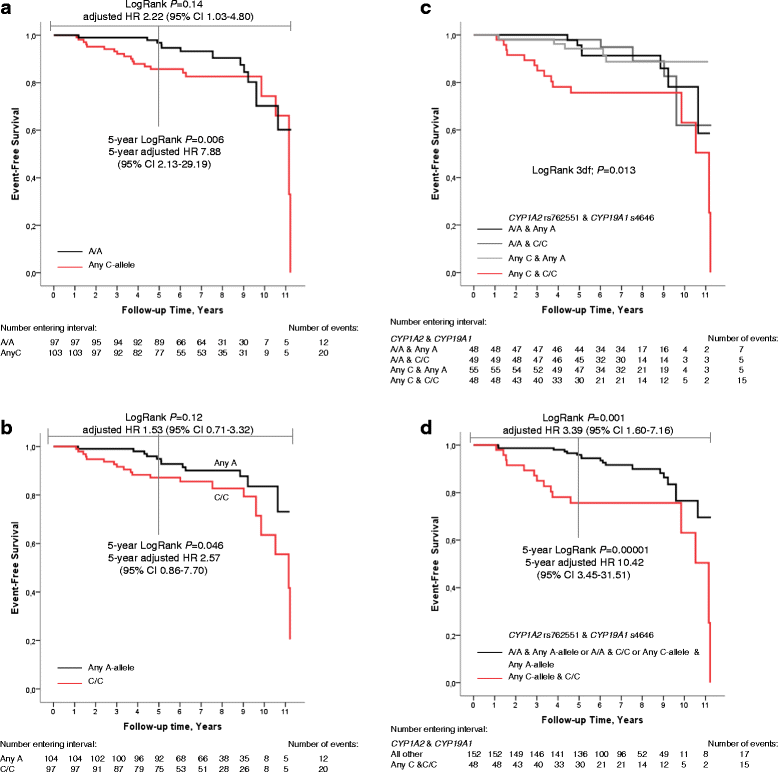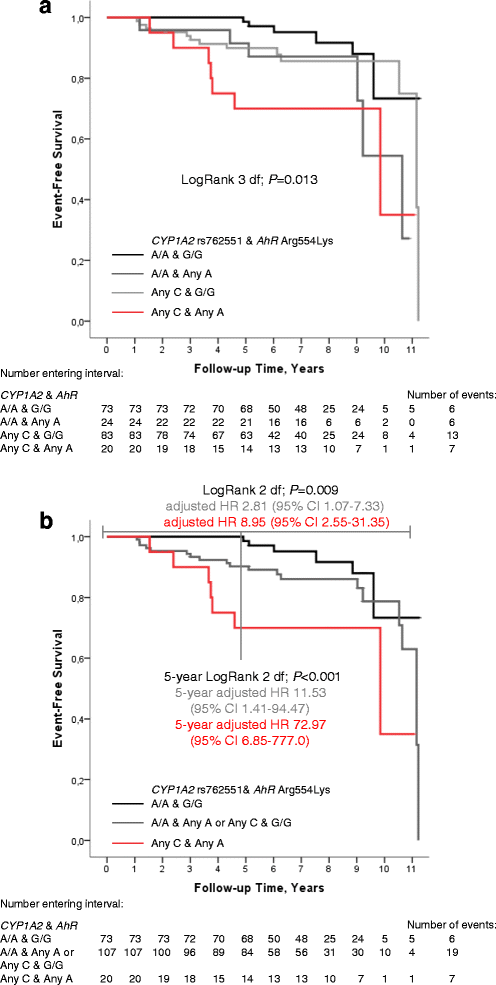CYP1A2--a novel genetic marker for early aromatase inhibitor response in the treatment of breast cancer patients
- PMID: 27029552
- PMCID: PMC4815192
- DOI: 10.1186/s12885-016-2284-3
CYP1A2--a novel genetic marker for early aromatase inhibitor response in the treatment of breast cancer patients
Abstract
Background: Endocrine resistance is a major obstacle to optimal treatment effect in breast cancer. Some genetic markers have been proposed to predict response to aromatase inhibitors (AIs) but the data is insufficient. The aim of the study was to find new genetic treatment predictive markers of AIs.
Methods: The ongoing population-based BC-blood study in Lund, Sweden includes women with primary breast cancer. This paper is based on AI-treated patients with estrogen receptor positive tumors who underwent breast cancer surgery in 2002-2008. First, an exploratory analysis of 1931 SNPs in 227 genes involved in absorption, distribution, metabolism, and elimination of multiple medications, using DMET™ chips, was conducted in a subset of the cohort with last follow-up in December 31st 2011 (13 cases, 11 controls). Second, selected SNPs from the first analysis were re-analyzed concerning risk for early breast cancer events in the extended cohort of 201 AI-treated with last follow-up in June 30th 2014. Clinical data were obtained from medical records and population registries.
Results: Only CYP1A2 rs762551 C-allele was significantly associated with increased risk for early events in the 24 patients (P = 0.0007) and in the extended cohort, adjusted Hazard ratio (HR) 2.22 (95% CI 1.03-4.80). However, the main prognostic impact was found within five years, adjusted HR 7.88 (95% CI 2.13-29.19). The impact of the CYP1A2 rs762551 C-allele was modified by a functional polymorphism in the regulator gene AhR Arg554Lys (G > A). Compared to patients who were homozygous for the major allele in both genes (CYP1A2 A/A and AhR G/G), a 9-fold risk for early events was found in patients who had at least one minor allele in both genes, adjusted HR 8.95 (95% CI 2.55-31.35), whereas patients with at least one minor allele in either but not both genes had a 3-fold risk for early events, adjusted HR 2.81 (95% CI 1.07-7.33). The impact of CYP1A2 rs762551 C-allele was also modified by the CYP19A1 rs4646 C/C, adjusted HR 3.39 (95% CI 1.60-7.16) for this combination. This association was strongest within the first five years, adjusted HR 10.42 (95% CI 3.45-31.51).
Conclusion: CYP1A2 rs762551 was identified as a new potential predictive marker for early breast cancer events in AI-treated breast cancer patients. Moreover, combined genotypes of CYP1A2 rs762551 and CYP19A1 rs4646 or AhR Arg554Lys could further improve prediction of early AI-treatment response. If confirmed, these results may provide a way to more personalized medicine.
Keywords: AhR; Aromatase inhibitor; Breast cancer; CYP19A1; CYP1A2; Polymorphisms; Treatment response.
Figures



Similar articles
-
S4646 polymorphism in CYP19A1 gene is associated with the efficacy of hormone therapy in early breast cancer.Int J Clin Exp Pathol. 2015 May 1;8(5):5309-17. eCollection 2015. Int J Clin Exp Pathol. 2015. PMID: 26191232 Free PMC article.
-
Influence of CYP19A1 polymorphisms on the treatment of breast cancer with aromatase inhibitors: a systematic review and meta-analysis.BMC Med. 2015 Jun 11;13:139. doi: 10.1186/s12916-015-0373-9. BMC Med. 2015. PMID: 26067721 Free PMC article.
-
CYP19A1 polymorphisms and clinical outcomes in postmenopausal women with hormone receptor-positive breast cancer in the BIG 1-98 trial.Breast Cancer Res Treat. 2015 Jun;151(2):373-84. doi: 10.1007/s10549-015-3378-3. Epub 2015 May 3. Breast Cancer Res Treat. 2015. PMID: 25935582 Free PMC article.
-
Research on aromatase gene (CYP19A1) polymorphisms as a predictor of endocrine therapy effectiveness in breast cancer.Rev Med Chir Soc Med Nat Iasi. 2012 Oct-Dec;116(4):997-1004. Rev Med Chir Soc Med Nat Iasi. 2012. PMID: 23700878
-
Pharmacogenetics of aromatase inhibitors.Pharmacogenomics. 2012 Apr;13(6):699-707. doi: 10.2217/pgs.12.28. Pharmacogenomics. 2012. PMID: 22515612 Review.
Cited by
-
Impacts of smoking on endocrine treatment response in a prospective breast cancer cohort.Br J Cancer. 2016 Jul 26;115(3):382-90. doi: 10.1038/bjc.2016.174. Epub 2016 Jun 9. Br J Cancer. 2016. PMID: 27280635 Free PMC article.
-
Interplay between AHR genotypes, lifestyle factors and adjuvant breast cancer treatments significantly impacts clinical outcome in a population-based cohort.BJC Rep. 2025 Jul 11;3(1):51. doi: 10.1038/s44276-025-00167-w. BJC Rep. 2025. PMID: 40646277 Free PMC article.
-
Intratumoural Cytochrome P450 Expression in Breast Cancer: Impact on Standard of Care Treatment and New Efforts to Develop Tumour-Selective Therapies.Biomedicines. 2021 Mar 12;9(3):290. doi: 10.3390/biomedicines9030290. Biomedicines. 2021. PMID: 33809117 Free PMC article. Review.
-
Germline genetic predictors of aromatase inhibitor concentrations, estrogen suppression and drug efficacy and toxicity in breast cancer patients.Pharmacogenomics. 2017 Apr;18(5):481-499. doi: 10.2217/pgs-2016-0205. Epub 2017 Mar 27. Pharmacogenomics. 2017. PMID: 28346074 Free PMC article. Review.
-
The Prognostic Impact of Intratumoral Aryl Hydrocarbon Receptor in Primary Breast Cancer Depends on the Type of Endocrine Therapy: A Population-Based Cohort Study.Front Oncol. 2021 May 20;11:642768. doi: 10.3389/fonc.2021.642768. eCollection 2021. Front Oncol. 2021. PMID: 34094928 Free PMC article.
References
-
- Fernö M, Borg Å, Johansson U, Norgren A, Olsson H, Ryden S, Sellberg G. Estrogen and progesterone receptor analyses in more than 4,000 human breast cancer samples. A study with special reference to age at diagnosis and stability of analyses. Southern Swedish Breast Cancer Study Group. Acta Oncol. 1990;29(2):129–35. doi: 10.3109/02841869009126532. - DOI - PubMed
Publication types
MeSH terms
Substances
LinkOut - more resources
Full Text Sources
Other Literature Sources
Medical

